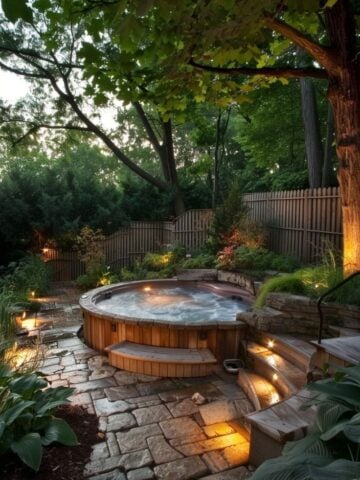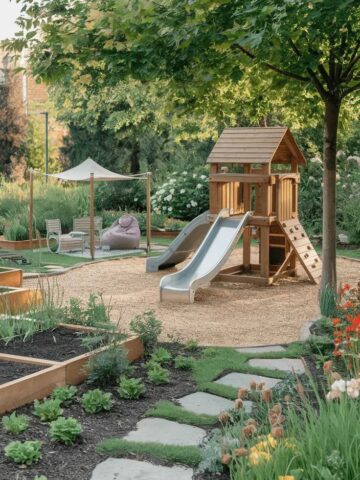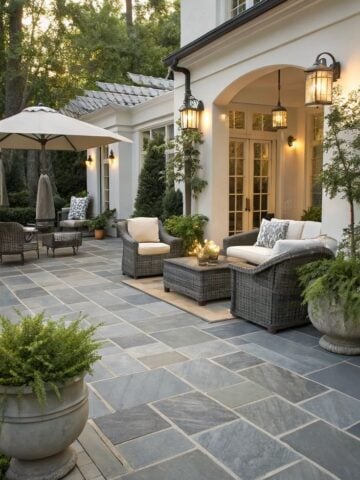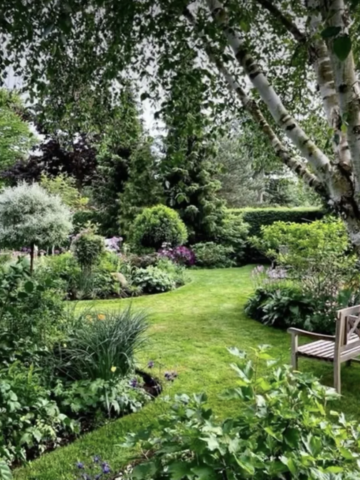Discover expert tips for installing composite decking on a slope with our comprehensive guide. Learn the essential do's and don'ts to ensure a sturdy, long-lasting deck. Read now for a flawless installation!
Disclaimer: this post may contain affiliate links, and every purchase made through these links will give me a small commission (at absolutely no extra cost for you!) AS AN AMAZON ASSOCIATE AND REWARDSTYLE MEMBER, I EARN FROM QUALIFYING PURCHASES. See Privacy Policy for additional info.
Installing composite decking on a sloped garden is an excellent way to make use of uneven terrain while creating a beautiful outdoor space. However, this type of project comes with unique challenges that require careful planning and execution. To help you achieve a durable and stylish result, here’s a comprehensive guide to the do’s and don’ts of installing composite decking on a slope.
The Do’s of Installing Composite Decking on a Slope
Do Plan Thoroughly
Before you get started, take the time to measure the slope accurately. Use a spirit level or laser level to assess the gradient and identify any potential problem areas. A detailed design plan is essential—think about features like drainage, stairs, or multi-level sections. Don’t forget to check your local council’s regulations, especially for raised decking, to avoid fines or legal issues.
Do Prepare the Ground Properly
A strong foundation starts with proper ground preparation. Clear away any vegetation, rocks, or debris, and stabilise the soil using gravel or landscaping fabric. If your slope has erosion problems, address these before installing the decking to ensure long-term stability.
Do Build a Solid Foundation
On sloped terrain, your decking’s foundation is crucial. Use concrete footings or adjustable deck supports to create a stable, level base. These supports should be securely anchored to prevent shifting over time, ensuring your deck remains safe and steady.
Do Consider Drainage
Sloped gardens often experience water runoff, so planning for drainage is a must. Design your deck with proper spacing between boards and consider installing a drainage system beneath it. This prevents water from pooling, which can cause damage to the structure.
Do Use High-Quality Materials
Invest in durable composite decking boards that are designed to withstand weather conditions. For instance, take a look at www.dino.co.uk. Opt for boards with a non-slip finish for added safety. Additionally, choose corrosion-resistant screws, fasteners, and brackets to extend the life of your decking.
Do Install Safety Features
Safety should always be a priority, especially for decking on a slope. Install sturdy railings or barriers to prevent accidents. For areas prone to rain, anti-slip coatings or strips can provide extra peace of mind.
The Don’ts of Installing Composite Decking on a Slope
Don’t Skip the Planning Stage
Rushing into the project without a clear plan is a recipe for disaster. Misjudging the slope’s gradient or failing to anticipate drainage needs can lead to an unstable deck. Take the time to plan every detail before starting.
Don’t Ignore Soil Stability
Loose or unstable soil can compromise the entire structure. Avoid installing decking directly onto untreated ground—this can lead to shifting or collapse over time. Stabilise the soil beforehand to ensure a firm base.
Don’t Neglect Drainage
It’s easy to assume that a slope will naturally handle water runoff, but that’s not always the case. Failing to account for drainage can lead to water pooling underneath the deck, which may cause rot or structural damage.
Don’t Use Subpar Materials
While it may be tempting to save money, low-quality materials won’t hold up on a sloped terrain. Avoid untreated wood for the frame, as it’s prone to warping and rot. Stick to high-quality composite materials for durability and longevity.
Don’t Overlook Maintenance Needs
Composite decking requires less upkeep than traditional wood, but it still needs some care. Neglecting cleaning or inspections can lead to dirt buildup or unnoticed damage, reducing the deck’s lifespan.
Tips for Making Composite Decking Child Friendly
Do you want to ensure that you can relax and allow your children to have fun on composite decking? Thankfully, this is a wonderful space you can use during the summer to get some fresh air, allow the kids to play and relax after a long day. But what happens when you want to go indoors for a while? Is it going to be safe enough to leave your children out on the composite decking? Generally, the answer is going to be yes. Here are some tips on how you can make sure this is the case.
Clean Up Debris
An easy way to care for your composite decking and keep the kids safe is by cleaning up loose debris. There can be a lot of branches and leaves falling throughout the year, which can create dampness on the decking. This can lead to mould growth, as well as allow bugs to gather underneath. So, make sure that you’re cleaning up this debris to avoid this situation.
Wash Away Algae
Something that you have to watch for on the surface of any decking is algae. This is going to become very slippery, particularly when it’s allowed to build up. So, you need to make a conscious effort to clean up the decking, particularly after winter. This can be done effectively with soapy, warm water and a soft-bristle brush.
Install Railings
Did you know that you can buy composite railings for decking? There are many companies that allow you to add this to your space and you can choose the same colour and style for your outdoor area. Not only can this look stylish and add the finishing touch to your decking, but it’s also going to make sure that it’s safe for your children. It will act as a barrier so that they’re kept within the boundaries. This is particularly useful when there’s a drop into your garden.
Conclusion
Installing composite decking on a slope may seem daunting, but with the right approach, you can create a stunning outdoor space that enhances your garden. By following these do’s and don’ts, you’ll avoid common pitfalls and ensure your decking is safe, stable, and beautiful for years to come.










Leave a Reply